Artwork by Lynette, Drawing Academy student
Thank you so much for your support. Here’s my drawing I did from life and a photo of the subject.
I am looking forward to your opinion.
Thank you
Lynette
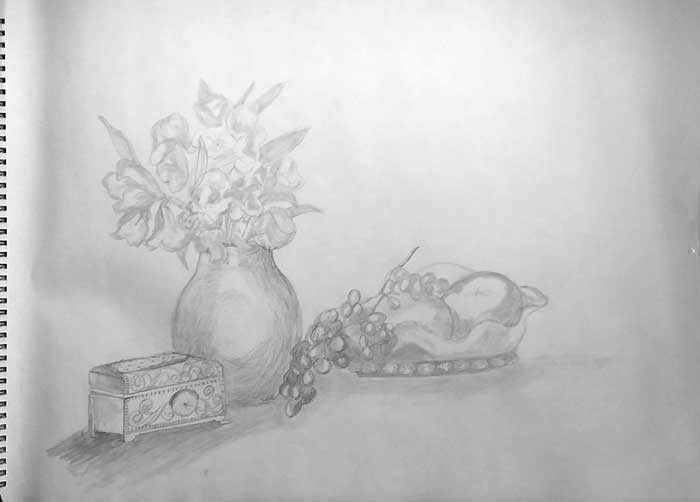

Dear Lynette,
Thank you very much for your still life drawing.
I like your artwork; well done. You did a good job achieving a likeness with objects and put considerable effort into rendering tonal values.
Next time you do a drawing from life, you may want to keep the following things in mind:
1. Composition
You arranged objects in life with balance and care; they look good together.
Also, it was the right decision to use a horizontal layout for this work.
However, the placement of items in the drawing can be improved. The main mass is shifted to the bottom left corner, which makes this artwork unbalanced. The composition would look better if you chose another scale and placement of drawing on a sheet of paper; see red vs green rectangles.
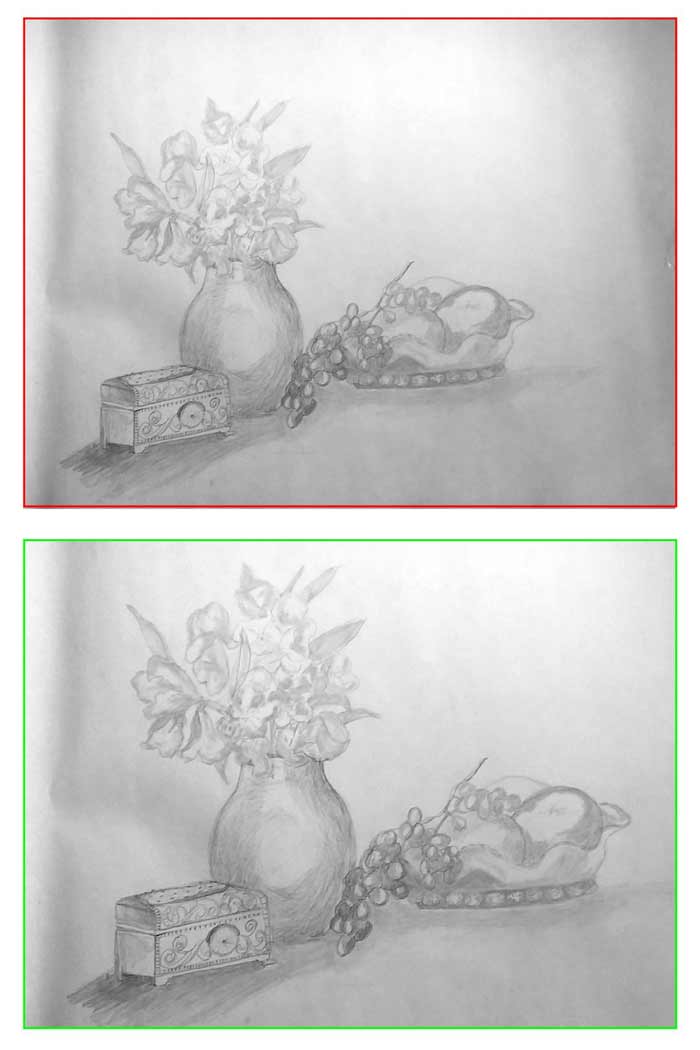
The composition is unbalanced because you missed the very first step – measuring and analyzing the overall proportions of a still life.
All small items are less important than the whole composition. Should you miss the first step, no decoration on a box will fix the composition.
2. Constructive drawing principles
There is one main thing you must work on to improve your drawing skills – mastering constructive drawing principles.
Many mistakes can be avoided if you know and use these principles – for example, drawing objects as if they are transparent, using linear and aerial perspective, checking proportions, using axes of symmetry and virtual lines of alignments and angles, employing cross-contours and so on.
These principles are not difficult. This is a very simple set of rules if you learn them one by one. With time and practice, constructive drawing will be very natural and almost subconscious for you.
Let’s examine some of the rules.
3. Linear perspective
For example, a box has a reverse perspective. You can see that red lines are not converging but diverging and therefore would never meet in one vanishing point on the horizon; neither would yellow lines.
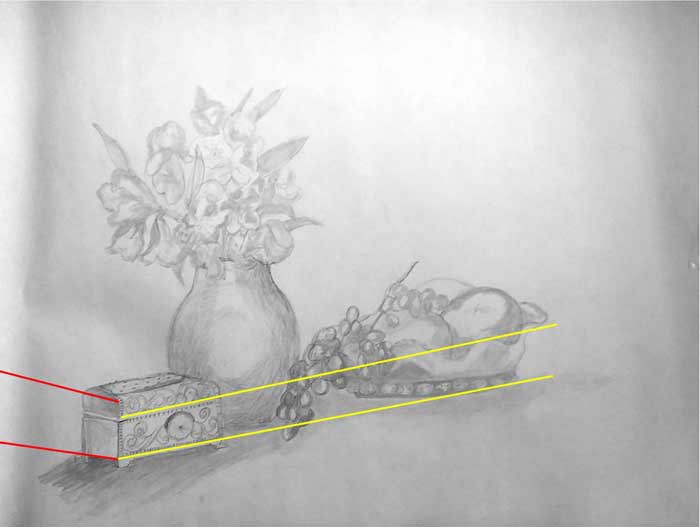
4. Axes of symmetry
There is no trace of any helpful lines like axes of symmetry, for example, in your drawing. A lack of guides makes it more difficult to draw symmetrical objects. Should you draw a virtual vertical axis of a vase and its horizontal axes, it would help to draw that object more symmetrically. It appears that the right “shoulder” of the vase is higher than its left one.
5. Alignments
The plate and vase are standing on a horizontal surface. Therefore, the axes of their bottom planes should also be horizontal.
Because you did not mark these axes, it was easy to miss that the planes in question are tilted – check red vs green lines.
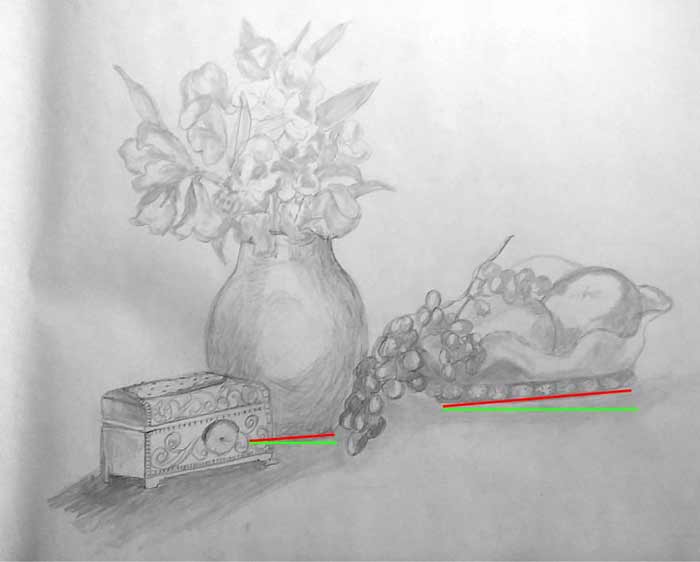
6. Proportions
Another very important element of constructive drawing is proportions.
Measuring and applying proportions means checking the number of times one dimension fits into another.
For example, the top of the vase in life fits into its widest part almost three times.
In your drawing, it is fewer than two times.
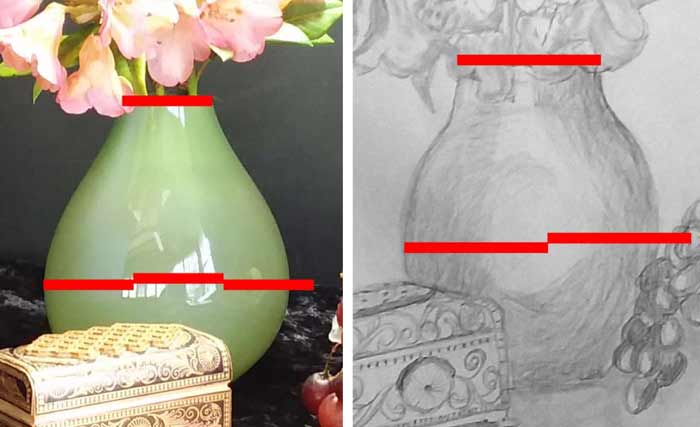
Many other mistakes and areas of improvement can be mentioned here, but I hope you can see the importance of constructive drawing principles and how they will help make your artwork better.
7. Tonal rendering
This is another big area for improvement.
Good tonal rendering is based on certain skills. There are many exercises you can do to get comfortable with handling a pencil, drawing good-quality lines, applying strokes along contours, controlling tonal values, developing your own beautiful style of rendering and so on.
I can’t cover everything here because it takes several years of daily practice to develop those skills.
Here’s the good thing – you have a lifetime Drawing Academy membership and can rely on unlimited support from the Academy tutors. Our support comes at no extra cost for as long as you need it.
Best regards,
Vladimir London
Drawing Academy tutor
To learn human anatomy fast, visit the Anatomy Master Class »
To learn professional drawing techniques,
Enroll in the Drawing Academy Course
Pay once - Enjoy forever!
Only $297





I am very impressed with the detailed explanation.